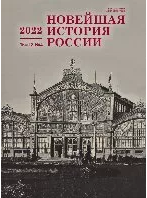Формы и методы борьбы с партизанским движением на пограничной территории Беларуси и Северо-Запада России
Forms and Methods of Combating the Partisan Movement on the Border Territory of Belarus and the North-West of Russia
Author(s): Elena E. Krasnozhenova, Svyatoslav Valentinovich KulinokSubject(s): Civil Society, Military history, Labor relations, Security and defense, WW II and following years (1940 - 1949), Fascism, Nazism and WW II, Peace and Conflict Studies
Published by: Издательство Исторического факультета СПбГУ
Keywords: Great Patriotic War; North-West; RSFSR; Belarus; occupation; partisan movement; crimes; intelligence; propaganda;
Summary/Abstract: The article examines the forms and methods of the Nazi occupation authorities’ struggle against the partisan movement on the border territory of Belarus and the North-West of Russia. From the very first days of the occupation of the region, the German occupation bodies and services paid considerable attention to the development of the most effective forms and methods of combating the partisan movement. The fight against the partisan movement was based on a variety of reconnaissance work: aviation and combat reconnaissance, visual observation, intelligence intelligence work. Agent cadres were trained in special training centers (courses and schools) created by the German special services. Another form of struggle against the partisan movement was the organization and training of pseudo partisan detachments. Committing crimes under the guise of partisans against the civilian population, pseudo-partisan units discredited the partisans in the eyes of the civilian population, thereby depriving the resistance movement of social support and support. The study noted that the most massive and brutal method of fighting the partisan movement was punitive operations aimed at eliminating partisan detachments and brigades, seizing food, mass destruction and seizure of civilians for subsequent forced labor. It is shown that under the guise of fighting partisans, the Nazis punished not only adults, but also children and adolescents. To fight the partisan movement, the invaders also used agitation and propaganda work. Orders were regularly posted in public places urging the population to fight the partisans. A special place was occupied by anti-partisan agitation in the periodicals. Under the occupation, the forms and methods of fighting the resistance movement against the Nazi regime were constantly improved taking into account the gaining practical experience of the struggle by the invaders.
Journal: Новейшая история России
- Issue Year: 12/2022
- Issue No: 41
- Page Range: 870-883
- Page Count: 14
- Language: Russian

